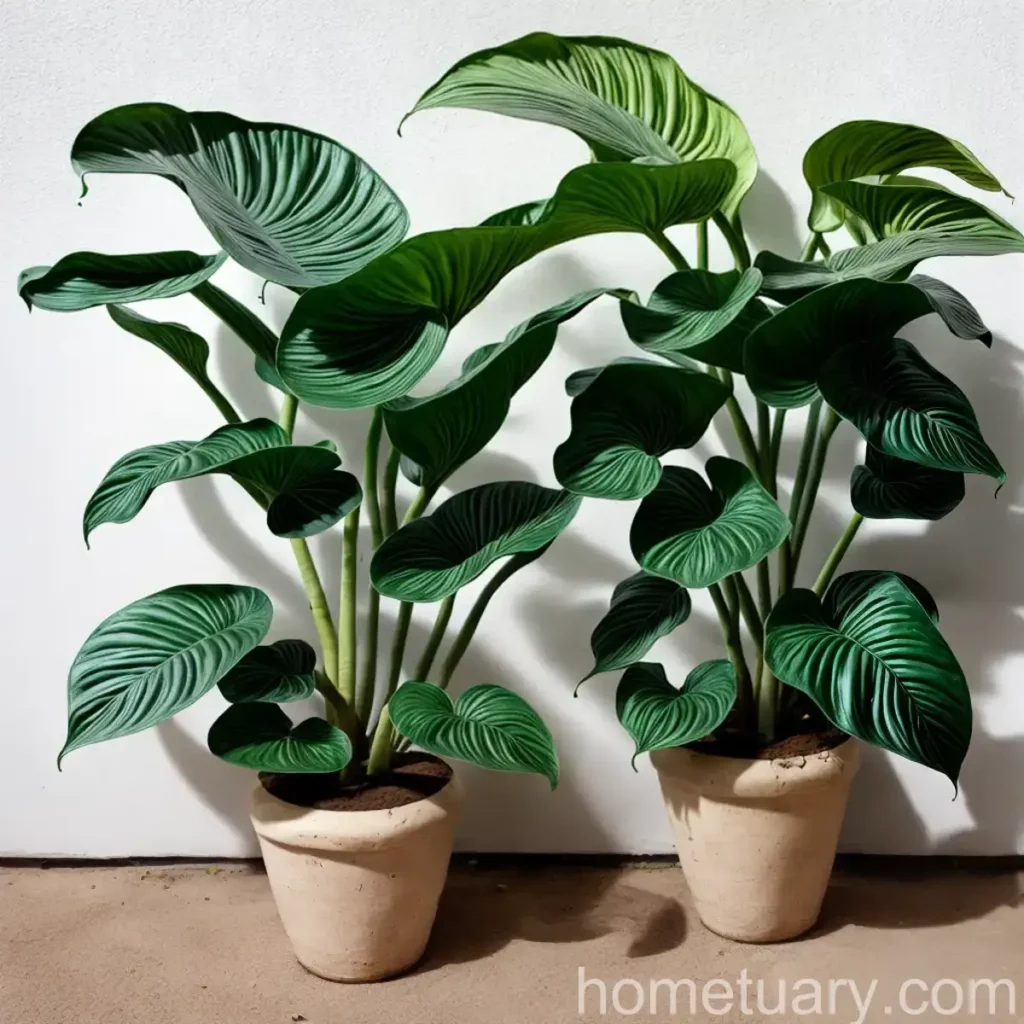Plant Scientist Blog: Understanding the Elephant’s Ear (Alocasia ‘Sarian’)
What is Plant: Elephant’s Ear (Alocasia ‘Sarian’)
The Elephant’s Ear (Alocasia ‘Sarian’) is a striking and majestic plant known for its large, lush, and distinctive foliage. Also commonly referred to as Elephant Ear or African Mask plant, Alocasia ‘Sarian’ is a member of the Araceae family and is native to the tropical and subtropical regions of Asia and Eastern Australia. This plant, with its stunning, elephant ear-shaped leaves, has become increasingly popular among plant enthusiasts due to its unique appearance and relatively low maintenance requirements. In this comprehensive guide, we will explore the various aspects of the Elephant’s Ear (Alocasia ‘Sarian’), ranging from its cultural significance and uses to its care routines, diseases, and pests.
Key Takeaways – Elephant’s Ear (Alocasia ‘Sarian’)
- Scientific Name: Alocasia ‘Sarian’
- Common Names: Elephant’s Ear, African Mask Plant
- Family: Araceae
- Native Habitat: Tropical and subtropical regions of Asia and Eastern Australia
- Distinctive Features: Large, lush, elephant ear-shaped leaves
- Popularity: Increasingly popular among plant enthusiasts
- Maintenance Level: Relatively low maintenance
- Special Considerations: Toxic to humans and pets if ingested
Now, let’s delve into the various aspects related to the care and maintenance of the Elephant’s Ear (Alocasia ‘Sarian’).
Culture
The cultural significance of the Elephant’s Ear (Alocasia ‘Sarian’) is derived from its striking appearance and symbolism in various cultures. For instance, in some Asian cultures, Alocasia plants are believed to bring good luck and are often incorporated into traditional medicinal and spiritual practices. Furthermore, the plant’s large, vibrant leaves have made it a popular ornamental choice in landscaping and interior design.
Uses
The uses of the Elephant’s Ear (Alocasia ‘Sarian’) range from ornamental and decorative purposes to traditional medicinal and spiritual applications. As an ornamental plant, it is often used to add a tropical and exotic touch to gardens, indoor spaces, and commercial landscapes. In traditional practices, certain parts of the plant are used for their purported medicinal properties, while the plant as a whole holds symbolic significance in cultural and spiritual contexts.
Water
Proper watering is essential for the health and vitality of the Elephant’s Ear (Alocasia ‘Sarian’). While it appreciates consistently moist soil, it is crucial to avoid overwatering, which can lead to root rot and other moisture-related issues. A general guideline for watering Alocasia ‘Sarian’ is to allow the soil to dry out slightly between waterings, and then provide thorough but careful watering to ensure proper moisture levels without waterlogging the soil.
Sunlight
Alocasia ‘Sarian’ thrives in bright, indirect light. It is important to shield it from direct sunlight, particularly during the intense midday hours, as this can scorch its leaves. However, insufficient light can result in stunted growth and diminish the plant’s overall vigor. Therefore, locating it in a spot with ample filtered sunlight is ideal for its growth and development.
Fertilizer
In terms of fertilizer requirements, Elephant’s Ear (Alocasia ‘Sarian’) benefits from regular, balanced feedings during the growing season. A well-balanced, water-soluble fertilizer with equal parts of nitrogen, phosphorus, and potassium, along with micronutrients, can support the plant’s foliage and overall health. However, it is important to taper off fertilization during the dormant period to prevent fertilizer burn and nutrient imbalances.
Soil
The choice of soil is critical for the well-being of Alocasia ‘Sarian’. A well-draining, nutrient-rich potting mix that retains moisture without becoming waterlogged is essential. A mixture of peat-based soil with perlite, orchid bark, or coarse sand can offer the ideal growing medium for the plant. Moreover, maintaining slightly acidic to neutral soil pH (6.0-7.0) is conducive to its growth and nutrient absorption.
Pruning
Pruning serves to maintain the plant’s shape, remove damaged or diseased foliage, and promote new growth. When pruning the Elephant’s Ear (Alocasia ‘Sarian’), it is important to use clean, sharp tools to make precise cuts and minimize stress on the plant. Additionally, removing spent flowers and yellowing leaves can enhance the plant’s appearance and redirect its energy into healthy growth.
Propagation
The propagation of Alocasia ‘Sarian’ can be achieved through various methods, including division, rhizome cuttings, or by utilizing offsets or pups that develop from the main plant. Each method has its own specific requirements and success rates, but overall, propagation offers an opportunity to multiply the plant and share its beauty with fellow enthusiasts.
Container Popularity
As an indoor plant, Alocasia ‘Sarian’ has gained popularity for its striking appearance and relatively manageable growth habit, making it an appealing choice for indoor enthusiasts. Its lush foliage and tropical allure bring an exotic touch to interior spaces, and the plant’s adaptability to containers makes it suitable for enthusiasts with limited outdoor gardening space.
Container Common Diseases
While Alocasia ‘Sarian’ is relatively resistant to most common diseases, it can be susceptible to issues such as leaf spot, root rot, and fungal infections if its care requirements are not met. Maintaining proper humidity levels, providing adequate airflow, and ensuring well-draining soil can help prevent these common container diseases.
Disease Diagnosis
Diagnosing diseases in Alocasia ‘Sarian’ involves careful observation of its foliage, growth patterns, and overall appearance. Common signs of diseases include leaf discoloration, spotting, wilting, and unusual growth. By identifying these symptoms and understanding the plant’s environmental conditions, it is possible to determine the specific disease affecting the plant and take appropriate remedial actions.
Common Pests
Alocasia ‘Sarian’ is prone to certain pests, including spider mites, aphids, mealybugs, and scales. These pests can affect the plant’s health and aesthetics by feeding on its foliage and sucking out vital sap. Regular monitoring, cultural practices, and targeted pest control measures can help mitigate pest infestations and safeguard the plant’s well-being.
Botanist’s Tips
- Maintain consistent, moderate humidity levels around the plant by utilizing a humidifier or pebble trays.
- Provide adequate airflow to prevent moisture-related issues and fungal infections.
- Monitor the plant for signs of stress, such as wilting or yellowing, and adjust its care routine accordingly.
- Avoid drastic temperature fluctuations, as Alocasia ‘Sarian’ prefers stable, warm temperatures.
Fun Facts
- The leaves of Alocasia ‘Sarian’ can grow to impressive sizes, with some reaching up to three feet in length.
- The distinctive venation and patterns on the foliage have led to the plant being compared to an elephant’s ear, contributing to its common name.
- Alocasia ‘Sarian’ is used not only for its ornamental appeal but also for its symbolism in various cultural and spiritual practices.
Links to External Resources
Now, let’s explore some reliable and informative resources that can further enhance your understanding and knowledge of the Elephant’s Ear (Alocasia ‘Sarian’):
- The Spruce: How to Grow and Care for Elephant Ear Plants
- Gardening Know How: Alocasia Sarian Plants – Tips for Growing An Alocasia Sarian
- Plant Care Today: Elephant Ear Plant: Growing Tips for Alocasia Polly and Elephant Ear Bulbs
By exploring these resources and incorporating their insights into your plant care routine, you can further optimize the growth and well-being of your Elephant’s Ear (Alocasia ‘Sarian’).
In conclusion, the Elephant’s Ear (Alocasia ‘Sarian’) is an enchanting and resilient plant that holds both cultural significance and ornamental appeal. By understanding its unique characteristics, care requirements, and potential challenges, enthusiasts can cultivate and enjoy the beauty of this majestic plant while contributing to its preservation and continued appreciation.
As a plant scientist, I am fascinated by the diverse array of plants and their intricate traits, and I hope this comprehensive guide provides you with valuable insights and inspiration to nurture your Elephant’s Ear (Alocasia ‘Sarian’) with care and appreciation. Through the cultivation and appreciation of plants like Alocasia ‘Sarian’, we not only enhance our plant care skills but also foster a deeper connection with the natural world around us.
Remember, each leaf of the Elephant’s Ear holds a story, a testament to its strength and resilience in adapting to the environments it graces. Let’s continue to celebrate and cherish the remarkable world of plants and the wonders they bring into our lives.















